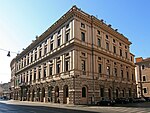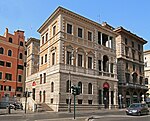Santissimo Sudario all'Argentina
17th-century Roman Catholic church buildings in ItalyBaroque architecture in RomeChurches of Rome (rione Sant'Eustachio)National churches in RomeRoman Catholic churches in Rome

Santissimo Sudario all'Argentina ([Church of] the Most Holy Shroud at the Argentina) or Santissimo Sudario dei Piemontesi (Church of the Most Holy Shroud of the Piedmontese) is a church in Rome, sited on the via del Sudario in the Sant'Eustachio district. It is the subsidiary church of the military orders in Italy. It was also once the national church of the Kingdom of Sardinia and is now the regional church for Piedmont and Sardinia. It houses a replica of the Turin Shroud.
Excerpt from the Wikipedia article Santissimo Sudario all'Argentina (License: CC BY-SA 3.0, Authors, Images).Santissimo Sudario all'Argentina
Via del Sudario, Rome Municipio Roma I
Geographical coordinates (GPS) Address Nearby Places Show on map
Geographical coordinates (GPS)
| Latitude | Longitude |
|---|---|
| N 41.896004 ° | E 12.475637 ° |
Address
palazzo Lavagi Pacelli
Via del Sudario
00186 Rome, Municipio Roma I
Lazio, Italy
Open on Google Maps











